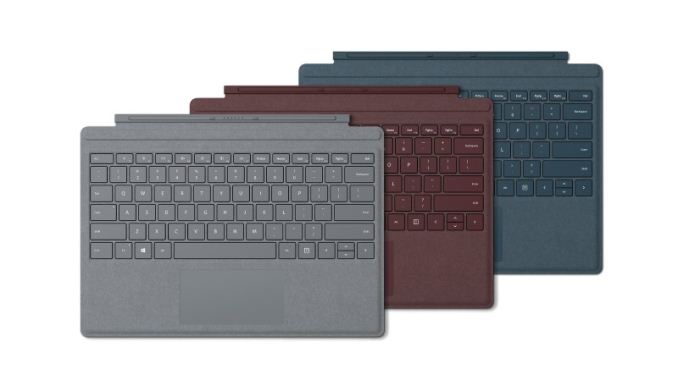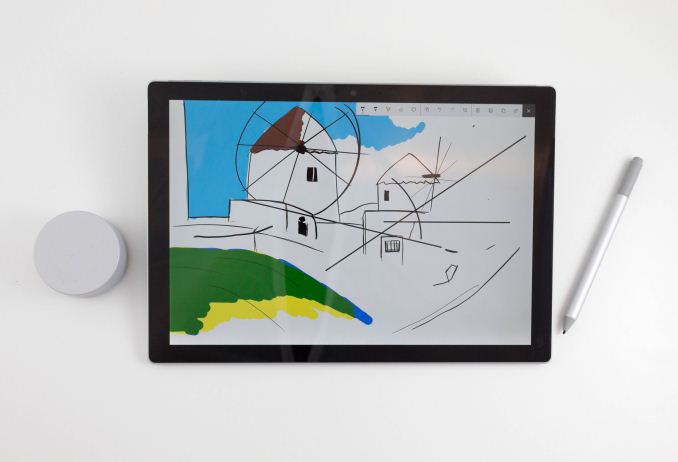The Microsoft Surface Pro (2017) Review: Evolution
by Brett Howse on June 15, 2017 9:00 AM ESTSurface Pro Signature Type Cover
It’s kind of funny that the current cover is still called the Type Cover, since the Touch Cover hasn’t been offered for several years now. Regardless, the latest Type Cover to be offered alongside the Surface Pro is a new version of the Signature model. The first Signature Type Cover was added to the Surface lineup shortly after the Surface Pro 4 was released, and it added a touch of luxury with an Alcantara fabric covering the keyboard.
The new Signature Type Cover will be offered in three colors, with Platinum, Burgundy, and Cobalt Blue options. It keeps the same design as the previous models, with 1.3 mm of key travel, and edge-to-edge island keys, so there’s not a lot of discuss there, but luckily the previous generation was already excellent.
The new Alcantara fabric is also covered with a polyurethane coating to improve durability. There’s certainly going to be some concern about how the fabric cover will hold up after several years of use and abuse, so the new coating should help alleviate some of that concern. The coating should also should help with liquid spills, and cleanup can be done with warm water and a mild detergent if needed. It feels like there’s almost no doubt that over time, the fabric will get a bit beat up, but it really does offer a nice feel when carrying the Surface Pro, or typing.
The New Surface Pen
Microsoft has been actively pushing the pen and inking experience in Windows for several years, so it makes a lot of sense that they would offer it in their own hardware products. They’ve continually improved the pen and ink on Surface for the last several years, and with the new Surface Pro, there is once again a new, improved pen.
Everyone loves to discuss the levels of sensitivity on digital pens, since unlike their analog cousins, there is always a graduated step, with the hope that there will be a small enough graduation that it’s difficult for a person to notice it. Surface Pro 3 was the first Pro model to drop the Wacom digitizer and move to an N-Trig pen technology, that Microsoft would end up acquiring shortly after. The Surface Pro 3 dropped from 1024 levels of sensitivity of the Wacom powered Surface Pro 2, to just 256 levels, but the Surface Pro 4 brought that back up to 1024 levels of sensitivity. For most people, that’s likely enough, but with Microsoft now courting the creativity crowd, the pen needed to improve further, and the new Surface Pen now offers 4096 levels of pressure sensitivity.
That’s always been the easy specification to quote for a pen, but there is a lot more to a pen experience than the levels of sensitivity. For pen fans, they’ll be happy to know that Microsoft has not overlooked those other factors with the latest generation.
One of the best features of the pen launched with the Surface Pro 4 was the tip feel. Unlike older pens, it offered a bit of traction on the display, and really made it feel more like it was actually drawing on the display. Like the previous pen, the new one also features replaceable tips, giving a choice of wider or thinner pen tips. The new pen keeps that same display friction too, which really makes it feel connected to the display.
Pen latency is arguably one of the most important aspects of a good digital inking experience, and it’s often one that gets less emphasis than other stats like pressure levels, but here the new pen improves again over the previous model, with just 21 ms of latency. Microsoft has a custom display controller to sense the pen, and with the lower latency, the latest generation is easily the best performing pen on Surface yet. One easy test to try is to draw circles on the screen quickly. The Surface Pro 4 would always have the ink lagging slightly behind where the pen was if the speed was moving quickly enough, but the new Surface Pro doesn’t have this issue at all. The ink appears to stay right under the pen.
Another unheralded feature is the amount of pressure required to start drawing, and the new Pen improves this dramatically. The outgoing version required 20 grams of force to be detected, but the new pen is just 9 grams, allowing much lighter drawing and shading options.
Finally, the one piece of the pen puzzle that Microsoft had really been lagging on was tilt support, and with the new pen, that is now available as well.
The pen is still powered by a AAAA battery, rather than being rechargeable, and battery life is expected to be around a year. The new pen also drops the pocket clip, but keeps the ability to stick to the Pro with magnets for transport. It would be nice to see a more solid mechanical device to hold the pen to the Surface, since the magnets are strong but still allow the pen to be dislodged in a bag. But for now, keep a close eye on the pen.
The new Surface Pen will work on any Surface device all the way back to and including the Surface Pro 3, and since many of the new features are part of the pen hardware, they will automatically work with other Surface devices with most of the features available. Meanwhile Microsoft is looking to upgrade the firmware of their pen controller of other Surface devices, such as the Surface Studio, to bring all of the improvements to the older hardware. The Surface Studio will really benefit from this Pen.
The final change from the Surface Pro 4 is that the pen is no longer included with the Pro. That’s because not all customers were using the pen, and it seems pretty plain that this was done in part to allow Microsoft to cut the cost of the device a bit, as we saw with the price-reduced Surface Pro 4 from earlier this year. Meanwhile for those users who do buy the new Surface Pen, it's available in colors to match the Signature Type Cover.













124 Comments
View All Comments
beggerking@yahoo.com - Monday, July 10, 2017 - link
Liar! how much is Crapple paying you?they never even made a sp3 with w7... in fact... my surface pro 1 came with windows 8...
Laxaa - Friday, June 16, 2017 - link
Brett, do you think it's worth upgrading from the SP4 for heavy usage (Adobe, SolidWorks) or should I get the Surface Book instead? I have the i5 w/8GB RAM and it's getting kind of limiting. At least when it comes to memory (SolidWorks keeps bugging me with low RAM warnings all the time)Or perhaps the XPS 15 would be a better choice?
Brett Howse - Friday, June 16, 2017 - link
Upgrading from SP4 to SP isn't something I would recommend to everyone, but you're in a situation where you needed a faster SP4 anyway. There's a big jump (as I'm sure you saw) from the i5 SP4 to this i7 model. Obviously the XPS 15 is much bigger, and has way more GPU, but you lose the portability.As much as this is an incremental upgrade over the 4, it's a lot of very nice small changes.
I can't recommend the Surface Book right now only because it's really in need of a refresh - especially the GPU - but I do like the Book very much if you need more performance and battery life. I'd hold off though and see after it gets an update.
Laxaa - Sunday, June 18, 2017 - link
I'll probably wait for a Book-refresh before I make a decision. The dGPU would probably be nice to have, and hopefully they can cram a Pascal-series GPU into the base.jrs77 - Friday, June 16, 2017 - link
If it wasn't for the spysoftware named Windows 10 I'd probably would get an i5-based Surface Pro.yhselp - Friday, June 16, 2017 - link
1.4 GHz on the CPU and 750 MHz on the GPU for sustained loads - expected, normal, but still somehow disappointing. You're essentially getting a very low-clocked dual-core CPU paired with about 580 GFLOPS of GPU with up to 100 GB/s memory bandwidth, if my amateur calculations are not entirely idiotic. Of course, said CPU having hyper-threading, AVX, L4 cache, and the latest Intel microarchitecture, certainly helps.I wonder what the m3-7Y30 in the entry model is capable of under a sustain load. I'd suspect about 550 MHz on the CPU and about 240 GFLOPS for the GPU.
BrokenCrayons - Friday, June 16, 2017 - link
Wikipedia has some information regarding the performance of the GPUs in question here:https://en.wikipedia.org/wiki/Intel_HD_and_Iris_Gr...
To summarize quickly, the 615 is rated at 345.6 - 403.2 GFLOPS and the 640 is capable of 729.6 - 806.4 GFLOPS, but that excludes variables specific to the Surface Pro in question.
Eliadbu - Friday, June 16, 2017 - link
Those absurd prices and base specs are so bad and the lack of ports. Also the fact that the keyboard and pen are purchased separately, it feels like Microsoft are going with their heads against the wall. Better wait for Eve-V value and the thinking of what the user needs are so ahead.zeeBomb - Friday, June 16, 2017 - link
Awesome write-up!ZipSpeed - Friday, June 16, 2017 - link
I bought a Surface Pro 4 last year thinking it could replace my iPad Gen 4 and 2010 Macbook Air in one fell swoop. Needless to say, I couldn't get use to the size of the device in tablet mode, and it wasn't very steady on my lap when I used the kickstand & type cover. I decided to return it, and even now, I'm still using my old (and slow) iPad and MBA as I continue my search.